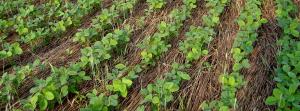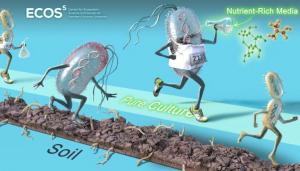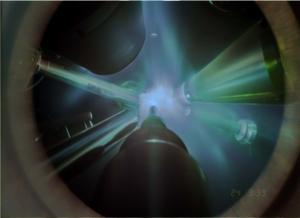LAB REPORT
Science and Technology Making Headlines
May 31, 2019


Climate fingerprints have shown that human activities point to a warming planet.
Pointing a finger at droughts
In a recent study, Lawrence Livermore scientists say they have detected the fingerprint of human-driven global warming on patterns of drought and moisture across the world as far back as 1900.
Rising temperatures are well documented back at least that far, but this is the first time researchers have identified resulting long-term global effects on the water supplies that feed crops and cities.
Among the observations, the researchers documented drying of soils across much of populous North America, Central America, Eurasia and the Mediterranean. Other areas, including the Indian subcontinent, have become wetter. They say the trends will continue, with severe consequences for humans.

Cover crops are planted between cash crop seasons to keep a living cover on the landscape. Numerous studies have shown these plants can help protect soil and water quality, store carbon, boost yields, increase forage availability and improve wildlife habitat.
Climate solution right under your feet
From increased wildfire damage and the threats from rising sea levels, to ocean acidification and the impacts on human migration patterns, the effects of global warming are being felt. To prevent these developments from turning potentially catastrophic, the world must stop the planet from warming 1.5°C above pre-industrial figures, say the world’s climate experts.
A growing number of experts say humans need to look downward, arguing that the carbon sequestering capacity of the soil under our feet has the potential to help tackle and reverse, perhaps significantly, human-caused global warming.
In the U.S., industrial farming practices like monocropping and routine tillage have led to the massive erosion of topsoil, where most of the carbon is stored. “Those practices are things that can be easily avoided,” said Roger Aines, chief scientist of the energy program at Lawrence Livermore National Laboratory. “When we’re dealing with sensitive soils, like in these wetlands and peat soils, you shouldn’t plow them or dig them up. When you’re dealing with soils that could blow away, you should keep a cover crop.”


A fast-growing microbe outperforms all other microbes when it’s in pure culture. However, microbes found in actual soil can gain the lead. Image by Northern Arizona University.
The secret lives of microbes
In a microbial footrace between different species, a fast-growing cell outperforms other cell types, as long as it enjoys the comforts of pure culture. But LLNL researchers and collaborators found that in real-world conditions, like those found in soil, the slower cell types can gain the lead.
Relationships between microbial genes and performance are often evaluated in the lab in pure cultures, with little validation in nature. The team showed that genomic traits related to laboratory measurements of maximum growth potential failed to predict the growth rates of bacteria in real soil.
Knowing the genomes of microorganisms can open a window into their secret lives: what they can eat, what they can breathe and how fast they can grow.


High-power lasers focus on the surface of a diamond, generating a sequence of shock waves that propagate throughout the sample assembly (from left to right), simultaneously compressing and heating the initially liquid water sample, forcing it to freeze into the superionic water ice phase. Credit: Millot, Coppari, Hamel, Krauss (LLNL)
It’s not cold as ice
A distinct form of solid water has been created and characterized by Federica Coppari and Marius Millot of Lawrence Livermore National Laboratory and their collaborators.
Ice XVIII exists at pressures 1-4 million times Earth’s atmospheric pressure and temperatures ranging from 3,000-5,000 degrees Fahrenheit. To reach such extreme conditions, the researchers pummeled ultrathin containers of liquid water with nanosecond ultraviolet pulses generated by six of the lasers at the University of Rochester’s Omega Laser Facility.
In their experiments, Millot, Coppari and collaborators established the conditions needed for ice XVIII for just a few nanoseconds. Those same conditions, along with abundant water, prevail inside the mantles of Neptune and Uranus. Exotic superionic ice XVIII could therefore exist in large quantities in the ice giants and host large-scale convective flows akin to the slow churning of Earth’s solid mantle.


LLNL and University of Nevada, Las Vegas scientists report a previously unknown pressure-induced phase transformation in TATB above 4 GPa (40,000 atmospheres of pressure). Image by Adam Connell/LLNL.
Explosive research
Lawrence Livermore scientists, in collaboration with University of Nevada, Las Vegas, have discovered a previously unknown pressure-induced phase transition for TATB that can help predict detonation performance and safety of the explosive.
1,3,5-Triamino-2,4,6- trinitrobenzene (TATB), the industry standard for an insensitive high explosive, stands out as the optimum choice when safety (insensitivity) is of utmost importance. Among similar materials with comparable explosive energy release, TATB is remarkably difficult to shock-initiate and has a low friction sensitivity. The causes of this unusual behavior are hidden in the high-pressure structural evolution of TATB.
Supercomputer simulations of explosives detonating, running on the world’s most powerful machines at LLNL, depend on knowing the exact locations of the atoms in the crystal structure of an explosive. Accurate knowledge of atomic arrangement under pressure is the cornerstone for predicting the detonation performance and safety of an explosive.





